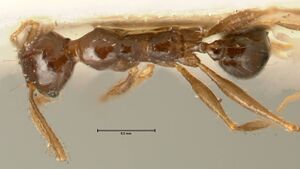Pheidole makilingi
| Pheidole makilingi | |
|---|---|

| |
| Scientific classification | |
| Kingdom: | Animalia |
| Phylum: | Arthropoda |
| Class: | Insecta |
| Order: | Hymenoptera |
| Family: | Formicidae |
| Subfamily: | Myrmicinae |
| Tribe: | Attini |
| Genus: | Pheidole |
| Species: | P. makilingi |
| Binomial name | |
| Pheidole makilingi Viehmeyer, 1916 | |
Nothing is known about the biology of Pheidole makilingi.
Identification
Distribution
Distribution based on Regional Taxon Lists
Indo-Australian Region: Philippines (type locality).
Distribution based on AntMaps
Distribution based on AntWeb specimens
Check data from AntWeb
Countries Occupied
| Number of countries occupied by this species based on AntWiki Regional Taxon Lists. In general, fewer countries occupied indicates a narrower range, while more countries indicates a more widespread species. |

|
Estimated Abundance
| Relative abundance based on number of AntMaps records per species (this species within the purple bar). Fewer records (to the left) indicates a less abundant/encountered species while more records (to the right) indicates more abundant/encountered species. |

|
Biology
Castes
Worker
Minor
      
| |
| . | |
Major
    
| |
| . | |
Nomenclature
The following information is derived from Barry Bolton's Online Catalogue of the Ants of the World.
- makilingi. Pheidole makilingi Viehmeyer, 1916b: 285 (s.w.) PHILIPPINES. See also: Eguchi, 2001a: 15.
Unless otherwise noted the text for the remainder of this section is reported from the publication that includes the original description.
Description
Worker
Eguchi (2001) - Major (lectotype). TL 3.4 mm; HL 1.60 mm; HW 1.47 mm; SL 0.93 mm; FL 1.30 mm; CI 92; SI 63; FI 88. Head broadest at about 2/3 distance of head (from anterior margin of c1ypeus to posterior margin of occipital lobe) (Fig. 8A); posterior margin of head in full-face view strongly emarginate; head in profile slightly concave on vertex (Fig. 8B); anteroventral margin of cranium almost straight, with three indistinct median processes. Clypeus without a median longitudinal carina. Eye situated at about 1/3 distance of head. Frontal carina distinct, extending to almost 2/3 distance of head. Antennal scrobe inconspicuous, running below the frontal carina. Antenna with 3-segmented club; scape extending to about 2/3 distance of head; terminal segment ca. 0.8 times as long as preceding two segments together. Masticatory margin of mandible with apical and preapical teeth, and a denticle in front of basal angle. Promesonotum in profile (Fig. 8C) forming a dome, with a distinct prominence on its posterior declivity. Mesopleuron without a distinct transverse impression. Propodeal spine ca. 2.5 times as long as diameter of propodeal spiracle. Petiole in profile cuneiform, ca. 1.4 times as long as postpetiole (excluding helcium); petiolar node in posterior view slightly emarginate at apex. Postpetiole in dorsal view subpentagonal, ca. 2.0 times as broad as petiolar node. Frons longitudinally rugose; vertex, and dorsal and lateral faces of occipital lobe rugoso-reticulate; promesonotum transversely rugose, with smooth and shining interspaces; mesopleuron and lateral faces of propodeum very weakly punctured but shining, and with several rugae; petiolar node smooth and shining; the remainder of petiole, and postpetiole and anterior part of first gastral tergite weakly punctured.
Minor (paralectotype). Head in full-face view elliptical (Fig. 8D); occipital carina well developed. Clypeus without a median longitudinal carina. Eyes situated just in front of midlength of head. Frontal carina and antennal scrobe present only around antennal insertion. Antenna with 3-segmented club; in full-face view scape extending beyond posterior border of head by more than its 1/3 length; terminal segment 0.8 times as long as preceding two segments together. Promesonotum forming a dome, with a gentle prominence on its posterior declivity (Fig. 8E). Mesopleuron without a transverse impression. Propodeal spine elongate-triangular, ca. 1.5 times as long as diameter of propodeal spiracle. Petiole in profile cuneiform, ca. 1.2 times as long as postpetiole (excluding helcium); petiolar node low, in posterior view not emarginate at apex. Postpetiole in dorsal view subpentagonal, ca. 1.9 times as broad as petiolar node. Head and promesonotum smooth and shining; mesopleuron and lateral face of propodeum puncutured slightly but shining; petiole, postpetiole and gaster almost smooth and shining.
Type Material
Eguchi (2001) - Major and minor; type locality: Luzon. Two syntypes (1 major and 1 minor, Berlin Museum für Naturkunde der Humboldt-Universität) were examined, of which the major is designated as the lectotype. The specimens are labeled as “Pheidole makingi”, although they are doubtless P. makilingi, because their locality and collector (Luzon, Baker) agree with those mentioned in the original description of P. makilingi.
References
- Eguchi, K. 2001b. A taxonomic study on Asian Pheidole (Hymenoptera, Formicidae): new synonymy, rank changes, lectotype designations and redescriptions. Insecta Koreana. 18:1-35. (page 15, see also)
- Viehmeyer, H. 1916b. Ameisen von den Philippinen und anderer Herkunft (Hym.). Entomol. Mitt. 5: 283-291 (page 285, soldier, worker described)


